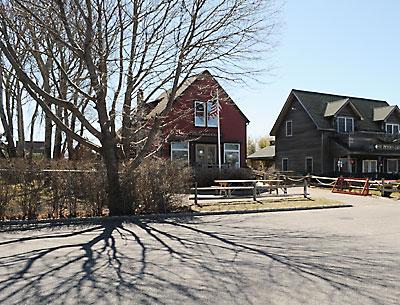Butt Heads Over Septic Waste
Butt Heads Over Septic Waste
Instead of having a consultant create a comprehensive wastewater management plan for East Hampton Town — a plan that is to include recommendations on environmental protection, ongoing surface and groundwater quality monitoring, meeting regulatory mandates, and what to do about the town’s currently inoperable scavenger waste treatment plant — Councilwoman Theresa Quigley suggested on Tuesday budgeting perhaps as much as $10 million to subsidize upgrades of private septic systems in ecologically sensitive areas of town.
Both Ms. Quigley and Supervisor Bill Wilkinson have opposed the plan put forward by the other three board members to hire a consultant, likely at a cost of several hundred thousand dollars, to collect data and draft an overarching plan before final decisions are made regarding the waste treatment plant, for instance. At the start of last year, the two were ready to sell the plant to the sole private company that had submitted a bid but were stymied when Councilman Dominick Stanzione, who had supported seeking bidders, agreed with the two new board members, Sylvia Overby and Peter Van Scoyoc, that the bid was unacceptable.
A committee that evaluated submissions by consultants interested in creating the town’s wastewater plan recommended that the board accept a proposal by a coalition comprising Lombardo Associates, a Massachusetts company, the FPM Group of Ronkonkoma, and the Woods Hole Group, along with Christopher Gobler, a Stony Brook Southampton professor. Mr. Wilkinson and Ms. Quigley criticized that recommendation Tuesday, but Mr. Stanzione said he would offer a resolution at tonight’s meeting to hire the group.
Lombardo Associates has developed a wastewater treatment system that can be used on a small scale. Ms. Quigley charged that, if the town hires Pio Lombardo as a consultant “he is going to be suggesting that we put his product in, his own product.”
“I’m suggesting that this man who’s selling the product is not going to find that there is nothing wrong,” she said. “There’s a foregone conclusion to this study, and that foregone conclusion is to shut down the plant and put Mr. Lombardo’s system all over town.”
The board voted unanimously on Jan. 8 to seek proposals for the comprehensive wastewater plan from four pre-qualified firms that had previously submitted outlines and any others. The proposals were vetted by a committee of town staffers that included the heads of the Planning and Natural Resources Departments.
Jeanne Carrozza, the town purchasing agent, told the board on March 19 that each was scored on 40 different criteria, with two proposals earning more than the 70 points needed for further review of their specifics and price. The firm selected for recommendation to the board “fully satisfies the requirements” outlined by the town board, she said, which included professional qualifications, financial responsibility, and the use of innovative technology.
Ms. Quigley took issue with the vetting process at the March 19 meeting, comparing it to a similar group evaluation applied several years ago to bids by vendors on town beach locations. “We tried this and it blew up in our faces,” she said.
In that process, a huge public outcry ensued when it was announced that a longtime Ditch Plain vendor had not made the grade and would lose its spot, and all vendors’ bids were thrown out by the board when it was discovered that not all had received the same information, invalidating the bids.
“If we are so concerned about our groundwater,” Ms. Quigley said Tuesday, the town would do better to give money directly to residents for septic system upgrades, “instead of having Mr. Lombardo and police coming to our septic tanks. Trust me, it is the next step,” she said.
Mr. Wilkinson pointed a finger at Mr. Stanzione. “This is a charade,” he said heatedly. “Dominick, you’re putting the public through a charade.”
Turning to Len Bernard, the town budget officer, Mr. Wilkinson ascertained that four votes — a supermajority of the board — would be needed to issue a bond to raise the money for the consultants’ fees. The money could come from bonds, Mr. Bernard said, or could be taken out of a surplus from the town operating budget.
“We’ll get it either way,” Mr. Stanzione told Mr. Wilkinson.
“Really, you know that?” the supervisor replied.
Mr. Bernard reported that borrowing $10 million for septic upgrades would add $700,000 a year to the town budget for 20 years, and would put an annual increase to the town budget, which must include unavoidable increases in costs for employee benefits and other items, over the state-imposed 2-percent tax increase cap.
However, any sum the town commits to underwriting septic upgrades would be unlikely to be expended in one year, Councilwoman Sylvia Overby pointed out.
“It’s a great idea to start thinking about septic upgrades,” Councilman Peter Van Scoyoc told Ms. Quigley. But, he added, “I don’t think it supplants the need to have the study.” One thing the wastewater management plan would do, he said, would be to identify, “scientifically,” the areas of the town where septic upgrades are most needed.
Should the town move forward with an upgrade program, he said, it would not necessarily mean issuing bonds to raise the money — other options, such as establishing a septic upgrade tax district could be explored, he said.
After establishing a Water Quality Protection Fund six months ago, Southampton Town officials recently began discussing an incentive program to help residents replace, repair, or upgrade aging or failing septic systems dating from 1981 or earlier. The proposal calls for providing up to $5,000 or 60 percent of the cost to homeowners who install systems verified by the County Health Department to reduce nitrates going into groundwater. Money from the water protection fund and rebates will be drawn from a Southampton Town budget surplus from 2012.


